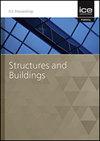Lower carbon dioxide cements and concretes: bringing new materials into UK industrial use
IF 1.4
4区 工程技术
Q3 CONSTRUCTION & BUILDING TECHNOLOGY
Proceedings of the Institution of Civil Engineers-Structures and Buildings
Pub Date : 2023-10-18
DOI:10.1680/jstbu.22.00182
引用次数: 0
Abstract
Cement and concrete are essential for global development. However, cement manufacture is responsible for around 7–8% of global greenhouse gas emissions with significant growth anticipated. Beyond efficiencies in cement manufacturing, other strategies to use less cement in construction through applying the principles of efficient design, circular economy and reuse also have the potential to reduce emissions. A further option is to move towards cements with different compositions and inherently lower embodied carbon. This paper focuses on these materials and the challenges to their widespread adoption; it draws mainly on applied research, trials and standardisation activities conducted in the UK and EU. In addition to modification of standards, basic technical and practical information such as strength development curves, durability, site considerations and a shared broad body of evidence are key for specifiers to consider using any new cement. The paper describes the role of standards and specifications and the underpinning information (applied research, published case studies and experience) essential in getting any new cement adopted. It also shows how a range of evidence from research and application can feed into a simple conceptual model and evidence base.低二氧化碳水泥和混凝土:将新材料引入英国工业用途
水泥和混凝土对全球发展至关重要。然而,水泥制造占全球温室气体排放量的7-8%左右,预计将有显著增长。除了提高水泥生产效率之外,其他通过应用高效设计、循环经济和再利用的原则来减少水泥在建筑中的使用的策略也有可能减少排放。另一种选择是转向具有不同成分和固有低碳含量的水泥。本文重点介绍了这些材料及其广泛采用所面临的挑战;它主要借鉴了在英国和欧盟进行的应用研究、试验和标准化活动。除了修改标准外,基本的技术和实用信息,如强度发展曲线、耐久性、场地考虑和共享的广泛证据,是规范者考虑使用任何新水泥的关键。本文描述了标准和规范的作用以及基础信息(应用研究,已发表的案例研究和经验)在获得任何新水泥采用中必不可少。它还展示了一系列来自研究和应用的证据是如何形成一个简单的概念模型和证据基础的。
本文章由计算机程序翻译,如有差异,请以英文原文为准。
求助全文
约1分钟内获得全文
求助全文
来源期刊
CiteScore
3.40
自引率
6.20%
发文量
61
审稿时长
12 months
期刊介绍:
Structures and Buildings publishes peer-reviewed papers on the design and construction of civil engineering structures and the applied research associated with such activities. Topics include the design, strength, durability and behaviour of structural components and systems.
Topics covered: energy conservation, people movement within and around buildings, strength and durability of steel and concrete structural components, and the behaviour of building and bridge components and systems

 求助内容:
求助内容: 应助结果提醒方式:
应助结果提醒方式:


